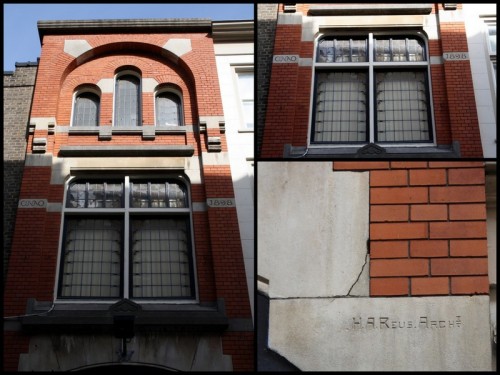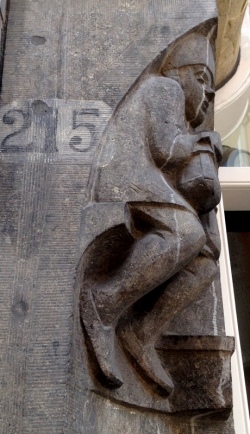Lambertus Arts or L Arts or Arts Lambertus or Arts L
This facade had been an eyesore for such a long fourth dimension that I had virtually given-up hope. The people who owned the place conspicuously didn't care very much about architecture nor did they realize how special their shop was. Their shopfront looked hideous. But… every bit all good things come up to an cease, patently bad things practice too: there's a new possessor who investigated the architect's drawings and had the shopfront restored to its original dazzler. What a relief…


Unfortunately, the original gable was removed in 1954 every bit information technology was in a state of busted. All the same are we able to enjoy the architect'southward original blueprint from 1897 thank you to the drawings at the Regionaal Archief Dordrecht (the city archives) and Kees Sigmond's written report for the Historical Association Oud-Dordrecht (magazine 2014-iii).


Reus, Zijl and Berlage
In 1898 Izaak de Goeije commissioned local architect Hendrikus Adrianus Reus (1872-1935) to build him a new shop on the lot of a much older property. De Goeije was a businessman from Rotterdam, who already endemic several buildings in Dordrecht.
Reus was notwithstanding a immature architect, barely 26 yr old, when De Goeije contracted him. He had graduated in 1894 from the Rotterdam Academy, and moved to Amsterdam for 2 years. According to Loet Megens, whom I consider the expert on Reus' life and work, it is very likely that Reus worked for Van Gendt architects during that time. And to be accepted as a student at Van Gendt, one of the major architects in Amsterdam, was considered a cracking laurels. Van Gendt designed many of import buildings in Amsterdam, and brash other eminent architects such every bit J.K. van der Mey, G.P.C. de Bazel en H.P. Berlage.
After Reus returned to Dordrecht, he worked on several projects with his begetter, who was also an architect. However, the young Reus had other ideas than Reus senior, and started to work for himself soon after. He was actually the first architect in Dordrecht moving away from the tradition to design according to previous styles. Reus began to develop his own manner. Yet we can recognise the influence of the much older architect Hendrik Petrus Berlage, the "Begetter of Modern Compages" in the netherlands. Reus must have been introduced to Berlage during his time in Amsterdam.
When we arroyo Reus' building, the beginning thing we observe are information technology's ruddy bricks. Reus ordered his bricks from the Dierense Steenfabriek J.1000. van de Loo. I detect it interesting that Reus designed this red edifice in Dordrecht while his 'idol' Berlage worked on the Commodity Exchange in Amsterdam; a building that is also characterized by information technology's cherry-red bricks.

Simply there'due south more than that links Reus to Berlage…
Amsterdam was sort of anincubator for the architectural scene. Genootschap Architectura et Amicitia, a Dutch architecture association founded in 1855, has played an imporant role in the development of Dutch architecture. Many leading architects as well every bit people from related disciplines have been a member: Springer, Cuypers, Van Gendt, Kromhout, De Klerk, De Bazel, Kramer, Berlage, Wijdeveld, Duiker, Rietveld, Van Der Vlugt, Dudok, Van Loghem and so on. Architectura et Amicitia was involved in the establishment of Vocational schools, they printed magazines, organised field trips, exhibitions and competitions. And there were numerous related societies, workshops and partnerships. So basically, all architects and artists knew each other!
Reus asked Lambertus Zijl (1866-1947) to make sculptures for his project in Dordrecht. The same Lambertus Zijl who fabricated the sculptures for Berlage's Commodity Exchange in Amsterdam! Zijl worked on both projects at the same time.
 Lambertus Zijl is, together with Joseph Mendes da Costa, considered one of the most important innovators of sculpture around 1900. Under influence of the emerging rationalism, he moved away from the academic traditions, and got his inspiration from archaic and medieval sculpture. Building and sculptures were to be integrated, they were to become a so called 'Gesamtkunstwerk'.
Lambertus Zijl is, together with Joseph Mendes da Costa, considered one of the most important innovators of sculpture around 1900. Under influence of the emerging rationalism, he moved away from the academic traditions, and got his inspiration from archaic and medieval sculpture. Building and sculptures were to be integrated, they were to become a so called 'Gesamtkunstwerk'.
Zijl developed a mode where the shape of the sculpture was almost completely integrated in the facade, without protruding or alluring much attention. Yous can clearly meet the similarities between his sculptures in Dordrecht (left and center) and the i (right) in Amsterdam.



The columns are made of a gray stone in a classical sectionalisation: base, shaft and majuscule; the capitals withal are of a more yellow kind of rock. We don't know what the images on the capitals mean, why they are there, but I recall the get-go 1 is depicts a coin being paid into an open up hand. The 2d ane is easy; those are flowers. Same for the tertiary i: ii mice. But the last one… well, your guess is as good every bit mine. Kees Sigmond suggests they might exist stylized lobsters.






Lambertus Zijl is likewise credited for the sculptures at Voorstraat 380 en Wijnstraat 239 in Dordrecht. And I but realised that the sculptures on the Reus building at Groenmarkt 70 at present need further investigation as we don't know who sculpted them… but those are other stories waiting to be told.
Pleased to run across that Art Nouveau architecture seems to be gaining appreciation once more, I contacted the possessor of the building. I was curious about his motivations and learned that he invested a significant amount of money in the refurbishment of the building, as he wanted "to bring back the original beauty of the building and safeguard information technology for the next 100 years". Being a schoolteacher (who wishes to remain anonymous), he has no other motives than "his love for architecture, craftsmanship and beautiful materials" knowing that he will never earn back the extra investment that was needed because he insisted on doing information technology right.
And thát, what he did, gives me promise. Hope for the future of the Art Nouveau architecture in my hometown. Promise for the time to come of neglected architecture in general. And promise for united states of america. May this little renovation project in Dordrecht exist the offset of many!
Source:
Amsterdam 1900 – Van Gendt Architecten
Dordt Eigen-aardig – Jaap Bouman (Commodity AD, Stad en Regio, twenty January 2015)
Tijdschrift 2014-3 van Vereniging Oud-Dordrecht (De Dordtse bouwsculpturen van Lambertus Zijl – Kees Sigmond)
Journal Stedelijk Museum Amsterdam
Lambertus Zijl Biografie
Quellinusschool for Sculptors in Amsterdam
Van Gendt Architecten, Amsterdam
Wikipage Architectura et Amicitia
Wikipage Beurs van Berlage
Read more?
- The consummate historical report (dated April 2014) about this building can be obtained from the Monuments & Archæology Section at Dordrecht Cityhall. For more data, click here.
- Albert van Engelenhoven, Dordtse Huizen in Bouwhistorisch Perspectief, afl. iii (dec. 1998). This magazine is dedicated solely to the architecture of H.A. Reus.
morrisontheirignishe.blogspot.com
Source: https://aboutartnouveau.wordpress.com/2015/05/02/voorstraat-273-dordrecht/
0 Response to "Lambertus Arts or L Arts or Arts Lambertus or Arts L"
Post a Comment